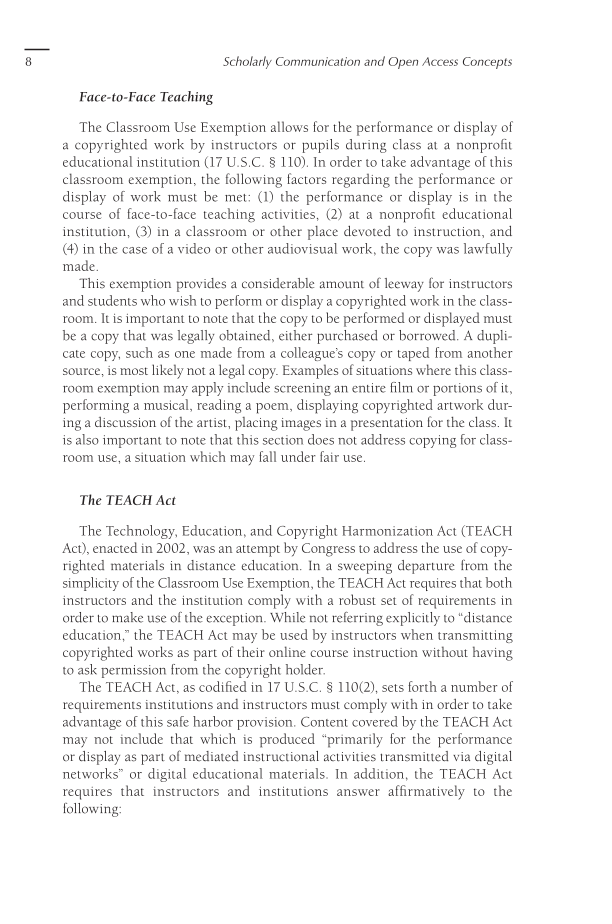8 Scholarly Communication and Open Access Concepts Face-to-Face Teaching The Classroom Use Exemption allows for the performance or display of a copyrighted work by instructors or pupils during class at a nonprofit educational institution (17 U.S.C. § 110). In order to take advantage of this classroom exemption, the following factors regarding the performance or display of work must be met: (1) the performance or display is in the course of face-to-face teaching activities, (2) at a nonprofit educational institution, (3) in a classroom or other place devoted to instruction, and (4) in the case of a video or other audiovisual work, the copy was lawfully made. This exemption provides a considerable amount of leeway for instructors and students who wish to perform or display a copyrighted work in the class- room. It is important to note that the copy to be performed or displayed must be a copy that was legally obtained, either purchased or borrowed. A dupli- cate copy, such as one made from a colleague’s copy or taped from another source, is most likely not a legal copy. Examples of situations where this class- room exemption may apply include screening an entire film or portions of it, performing a musical, reading a poem, displaying copyrighted artwork dur- ing a discussion of the artist, placing images in a presentation for the class. It is also important to note that this section does not address copying for class- room use, a situation which may fall under fair use. The TEACH Act The Technology, Education, and Copyright Harmonization Act (TEACH Act), enacted in 2002, was an attempt by Congress to address the use of copy- righted materials in distance education. In a sweeping departure from the simplicity of the Classroom Use Exemption, the TEACH Act requires that both instructors and the institution comply with a robust set of requirements in order to make use of the exception. While not referring explicitly to “distance education,” the TEACH Act may be used by instructors when transmitting copyrighted works as part of their online course instruction without having to ask permission from the copyright holder. The TEACH Act, as codified in 17 U.S.C. § 110(2), sets forth a number of requirements institutions and instructors must comply with in order to take advantage of this safe harbor provision. Content covered by the TEACH Act may not include that which is produced “primarily for the performance or display as part of mediated instructional activities transmitted via digital networks” or digital educational materials. In addition, the TEACH Act requires that instructors and institutions answer affirmatively to the following:
Document Details My Account Print multiple pages
Print
You have printed 0 times in the last 24 hours.
Your print count will reset on at .
You may print 0 more time(s) before then.
You may print a maximum of 0 pages at a time.





















































































































































































